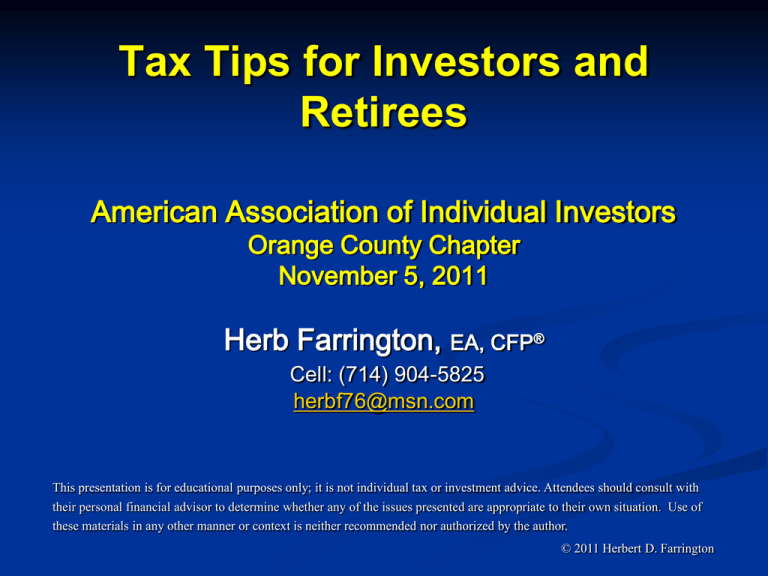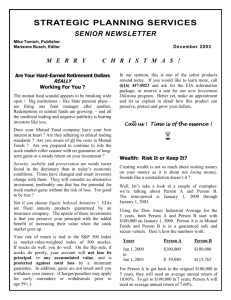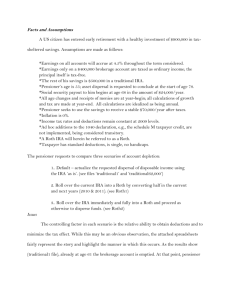Tax & Investment Planning - Robert's General Services
advertisement

Tax Tips for Investors and Retirees American Association of Individual Investors Orange County Chapter November 5, 2011 Herb Farrington, EA, CFP® Cell: (714) 904-5825 herbf76@msn.com This presentation is for educational purposes only; it is not individual tax or investment advice. Attendees should consult with their personal financial advisor to determine whether any of the issues presented are appropriate to their own situation. Use of these materials in any other manner or context is neither recommended nor authorized by the author. © 2011 Herbert D. Farrington Income Taxes Over and over again the Courts have said that there is nothing sinister in so arranging affairs as to keep taxes as low as possible. Everyone does it, rich and poor alike and all do right, for nobody owes any public duty to pay more than the law demands: Taxes are enforced exactions, not voluntary contributions. -- Learned Hand, US Appeals Court Judge Political Statement: “Figures Don’t Lie, But Liars Figure” My receptionist pays a higher tax rate than me (35% vs. 17.4%). Truth: The 35% tax bracket starts at income of $379,151 $379,151 in taxable income results in tax of $110,017 (29%) Is Buffet’s receptionist really making that much ? Warren Buffett’s salary is $100,000 Very low for the CEO of a multi-billion dollar company He’s structured his “compensation” to be through capital gains and dividends (15% tax rate). Buffett’s AGI: $63 million, Taxable Income: $39 million, $24 million? Did he pay too little? Berkshire paid $5.6 billion in income taxes in 2010, Buffet owns 37% x $5.6 billion = his share $2.07 billion Oranges vs. Apples It appears he was comparing his effective tax rate vs. his receptionist’s top marginal rate plus Social Security tax. Unintended Consequences Any item of income or loss can affect taxes on other income. The tax code is complex, sneaky, illogical & unfair ! Higher income can put you into a higher tax bracket Social Security can go from 0% taxable to 50% or 85% Medicare: you can be subject to: Surcharge on your Medicare premiums Obamacare tax on investment income Phase-out of deductions for residential rental losses Can make you subject to AMT Returning in 2013: Phase-out of personal exemptions Returning in 2013: Phase-out of itemized deductions Strategies: Defer recognition of taxable income Convert taxable income to tax-deferred income or tax-free income Asset Allocation Strategy: Where to Hold Your Investments Taxable Accounts Stocks, Mutual Funds, ETFs LT Capital Gains receive 0-15% tax rate Qualified Dividends receive 0-15% tax rate Capital Losses can offset other income If these investments are in an IRA: ordinary tax rates (up to 35%) Tax-free Municipal Bonds Can avoid both Federal and California income taxation Private activity bonds are subject to AMT Tax-deferred Accounts: Traditional IRAs, 401(k)s, Annuities Bonds, Money Markets, CDs, ETNs Earnings within these accounts are tax-deferred Put your “income” (interest) investment allocation here Upon withdrawal, all income is taxed at ordinary tax rates (up to 35%) Tax-free Accounts (Roth IRAs) No income tax consequences (usually) Focus only on maximum investment return Taxable Investment Accounts Federal Qualifying Dividends & Long Term Capital Gains: 0% if Taxable Income <$34,500 single, <$69,000 MFJ 15% if Taxable Income higher Non-qualifying Dividends, Interest & Short Term Gains: up to 35%+ tax rate Rental real estate: Accumulated Depreciation upon sale: 25% rate Collectibles: 28% rate $3000 maximum deductible capital loss per year (since 1978) 2013: LTCG rate goes to 20% + 3.8% = 23.8% 2013: Dividends: Up to 35% + 3.8% = 38.5% California There is no special rate for dividends & capital gains Ordinary income tax rates apply: up to 9.3% Tax Planning Tip for a Taxable Account Get the 0% Federal income tax rate Keep your “Taxable Income” below $69,000 (MFJ) and: Qualifying Dividends & Long Term Capital Gains will have a 0% tax rate ! Example: If your other Taxable Income is $40,000 then you could have $29,000 in capital gains and/or qualified dividends that will have a 0% tax for federal purposes California There is no special rate for dividends & capital gains, so there would be California income tax on your capital gains and dividends. Tax Planning Tip - Continued If your Taxable Income is under $69,000 (MFJ) and you own some stock that has risen in value: 1. But you would like to sell it and buy another stock, use the “taxfree” opportunity described previously. Then you’ll have the stock you really want and won’t have to pay any federal income tax on the trade. 2. And you want to keep the stock, use the “tax-free” opportunity described previously. Then re-buy the stock. You will now have a higher cost basis, so if you sell it in the future, you will have a lower taxable gain. Remember capital gain tax rates are scheduled to rise in 2013. Tax Planning Tip: Mutual Funds Be careful about buying a mutual fund late in the year Mutual funds make distributions in December and they are taxable. The price of mutual funds tends to rise in November and December, in anticipation of the distribution. After the distribution, the price of the mutual fund drops in proportion to the distribution paid. Buying late in the year can result in you paying for a taxable distribution that you don’t get full value for. IRAs: Traditional vs. Roth Traditional IRA Investment gains are taxdeferred Withdrawals are taxed at ordinary income tax rates RMDs after age 70½ Withdrawals by beneficiary are taxed at ordinary income tax rates IRA balance at death is subject to estate taxes Roth IRA Investment gains are taxfree Withdrawals are tax-free No age 70½ RMDs Withdrawals by beneficiary are tax-free IRA balance at death is subject to estate taxes Each dollar in a Roth IRA is more valuable than a dollar in a traditional IRA Traditional IRAs: Required Minimum Distributions Age 70 ½ before 2011 RMD for 2011 due on or before December 31, 2011 Age 70½ in 2011 RMD for 2011 must be made on or before April 1, 2012 RMD for 2012 on or before December 31, 2012 Therefore, 2 RMDs may be required in 2012 if you delay first distribution (double income, double or more tax) Required Minimum Distributions 2011 Calculate by using: IRS’ Uniform Lifetime Table for age at end of current year IRA market value as of end of prior year Example: Age 72 as of Dec. 31, 2011 IRS factor is 25.6 IRA market value as of Dec. 31, 2010 = $100,000 * $100,000 divided by 25.6 = $3907 * Whether market value is now $50,000 or $150,000 Don’t like Required Minimum Distributions ? Direct Charitable Contribution Strategy Tax-efficient strategy for those who make charitable contributions Funds flow directly from your IRA custodian to the charity Can be the full amount or a partial amount of your RMD The RMD-contribution is not be taxable The RMD-contribution is not deductible What’s the advantage? This avoids putting you into a higher tax bracket This avoids reductions in deductions and credits This strategy is available through 2011, those age 70 ½ + Maximum contribution: $100,000 Required Minimum Distributions Other Retirement Accounts Inherited IRAs, 401(k), 457, 403(b) plans Same rules for IRAs Exception for those still working Except 5%+ owners Roth IRAs, Roth Accounts in employer plans No RMDs during your lifetime Your heirs can make withdrawals over their lifetime Have You Hugged Your 8606 Lately? It Can Save You Thousands of Dollars Nondeductible IRA Contributions to Traditional IRAs Such contributions are recovered tax-free over life 1. Amounts for current year and prior years 2. Total market value of your traditional IRAs 3. 1. divided by 2. equals tax-free ratio Roth Conversion Information Roth IRA Distributions Worksheet for Form 8606 IRA Contributions: Deductible & Nondeductible Federal & California Tax Year 1975 1976 -1981 Maximum Deductible Contribution Federala California $ 1500 $ 0b 1500 1500b 1982 - 1986 2000 1500b 1987 - 1993 2000 2000 1994 - 2001 2000 2000 2002 - 2004 3000 + 500 4000 + 500 4000 +1000 5000 +1000 3000 + 500 4000 + 500 4000 + 1000 5000 + 1000 2005 2006 - 2007 2008 – 2011 Comments No California deduction If active participant (AP) in employer retirement plan: No Federal and No California deduction. If AP: Federal deduction allowed, No California deduction If AP: Amount deductible depends on MAGI. Calif. deduction, if any, based on Calif. net income. If AP: Amount deductible depends on MAGI. If AP: Amount deductible depends on MAGI. If age 50+ then an extra $500 If AP: Amount deductible depends on MAGI. If age 50+ then an extra $500 If AP: Amount deductible depends on MAGI. If age 50+ then an extra $1000 If AP: Amount deductible depends on MAGI. If age 50+ then an extra $1000 Deceased Retiree with a Wife under 59 ½ Treating a deceased spouse’s IRA as your own IRA can reduce or delay the RMDs and taxes but… Tax trap if the surviving spouse needs money now Withdrawals taken before age 59 ½ are subject to the 10% early withdrawal tax (plus 2% for California) RMDs are not required until spouse turns 70 ½ Alternatively, you can treat IRA as an inherited IRA RMDs start year after death and based on beneficiary’s age, or Beneficiary may receive entire distribution within 5 years of death No RMDs or early withdrawal penalty tax Distribution is taxable in year received Reasons to Convert to a Roth IRA 1. Avoids RMDs after age 70 ½ 2. If you have a special tax situation • • • • • Low year of income Business Losses Tax credits Suspended real estate rental losses High Charitable Contributions (current or carry-overs) 3. If you have non-deductible contributions in your IRA • They are not taxable at conversion 4. Have non-IRA funds available to pay income tax on conversion 5. If you think income tax rates will rise in the future • 2013 rates are scheduled to go up Reasons to Convert to a Roth IRA (continued) 6. Exposure to AMT can be reduced in future years 7. Avoiding higher income taxes after one spouse dies • Married joint tax rates are lower than single rates • Pay tax now at lower rates married joint rate 8. Large estates: pay income taxes now, reduces estate • After-tax value of traditional IRA = total value of Roth IRA 9. Time is on the side of Roth IRAs (tax-free compounding of returns) • Your lifetime • Spouse’s lifetime • Children’s lifetime Roth IRA Conversion Strategies 1. Start-of-Year Strategy: Convert Annual Cash Need Amount Anyone withdrawing from their IRA should consider this option ! Determine cash needed for year from Traditional IRA Convert (transfer) that amount from Traditional IRA to Roth IRA Withdraw cash, as needed, during year from Roth IRA Income tax on conversion: same as monthly withdrawals Tax saving: current year investment earnings are in Roth (taxfree) instead of Traditional (tax-deferred) Example: Annual cash need: $ 84,000 Convert in January: $ 84,000 Withdraw monthly: $ 7,000 Total Roth withdrawals: $ 84,000 Year end Roth balance: $ 3,241* (future tax-free withdrawal) * 8% rate of return, withdrawals on first of each month Roth IRA Conversion Strategies 2. Larger Amount Strategy, Consider: If you have a low income year If you think future tax rates will be higher Be careful not to convert too much in a year Income tax rates are progressive Remember “unintended consequences” Can adjust or reverse amount converted until Oct. 15 of following year How About a Do-Over ? Roth IRA Conversion and Do Over Strategy 1. Convert Traditional IRA to a Roth IRA • All, or a portion 2. Amount converted is taxable 3. Conversion can be reversed (Recharacterization) • If you later find that taxes are too much, or • Investments have not done well • Eliminates taxable event Roth IRA Recharacterization To Do-Over or Not , that is the question Will the tax laws change in the future ? If tax rates increase = reason to retain conversion If tax rates go down = reason to recharacterize Return on investments in Roth IRA Gains = reason to retain conversion Losses = reason to recharacterize You have until October 15 of the year following conversion to decide whether to keep conversion or recharacterize Roth IRA Conversion – Recharacterization Strategy Segregate your IRA by investment class Divide your Traditional IRA into 2 or more IRAs Place “growth” assets in one IRA, “income” assets in other IRA Convert some or all of each type Convert twice as much as you would like to keep converted Several months later: Keep the Roth with the greatest gain Recharacterize the Roth with the lower gains Other income Amount of other income will affect decisions Recommend paying conversion taxes from non-IRA accounts If 59½ + : 5 years since first Roth IRA If under 59½ : 5 years since conversion Can recharacterize all or a portion Roth IRA Example Roth IRA values At Conversion: IRA A: $ 30,000 IRA B: $ 30,000 Combined: $ 60,000 10/15/2011: $ 68,000 $ 28,000 $ 96,000 Choices: 1. 2. 3. Keep both Roth IRAs: Taxed on $60,000; the $ 36,000 gain is taxfree and future gains on $96,000 balance are tax-free. Full recharacterization: No amount is currently taxable, but full $96,000 is taxable in the future. Best: Recharacterize IRA B only: Taxed on $30,000; $38,000 is tax-free and future earnings on $68,000 will be tax-free Has Your Roth IRA Lost Money ? (When You Have Lemons, Make Lemonade ) Roth IRA investment losses can be tax deductible! Roth contributions + converted amounts less cash withdrawn from Roth IRA Miscellaneous Itemized Deduction, subject to 2% AGI limitation Requires tax-free withdrawal of all remaining balances in Roth IRA Roth IRAs: Convert previously and now have a loss? Recharacterize (unwind) prior conversion Reconvert and use the new market value as the taxable amount Medicare Part B Premium Surcharge 2012 premium based on 2010 MAGI (AGI plus “tax-exempt” income) Medicare monthly premiums for 2012: Single Taxpayer: Married Taxpayer: Mo. Premium: MAGI under $85,001 $ 85,001- $107,000 $ 107,001- $160,000 $ 160,001- $214,000 $ 214,000+ MAGI under $170,001 $ 170,001-214,000 $ 214,001-$320,000 $ 320,001-$428,000 $ 428,000+ $ 99.90 $ 139.90 $ 199.80 $ 259.70 $ 319.70 You can appeal surcharge if “Life Changing Event” Marriage, Divorce, Death of Spouse, Stopping Work Involuntary loss of income (natural disaster, insolvent pension) High income due to sale of property is not a LCE “Obamacare” Taxes New taxes 10% excise tax on indoor tanning services 2.3% excise tax on medical devices sold to hospitals, clinics, etc. 2013: Additional Medicare tax of .9% on wages & self-employment income (from 2.9% to 3.8%) Singles: MAGI over $200,000 Married-joint: $250,000 2013: medical deduction threshold rises from 7.5% to 10% This reduces your chance of using as itemized deductions If age 65+, 7.5% applies until 2017 No delay for AMT purposes “Obamacare” Taxes New Taxes – continued Employers 40% “Cadillac tax” on rich plans, effective 2018 Employers must report value of health plans on W-2s Not taxable… yet Doesn’t apply to President’s or Congress’ medical plans Penalty tax for no medical insurance Starting in 2014 Paid with tax return $95 - $695 (or % calculation) Court challenges & decisions as “unconstitutional” ? “Obamacare” Taxes New Tax on investment income Effective 2013 Dividends, interest, annuities, royalties, rents, capital gains Rate: 3.8% Singles: MAGI over $200,000 Married-joint: $250,000 Sale of personal residence Excluded gain ($250,000 or $500,000) not taxed Excess of above is subject to this new tax Gain over above limits: 20% + 3.8% = 23.8% federal tax Thinking of selling your home? Think about selling before 2013 Especially when you add California income taxes Sale of second or vacation home No $250M/$500M exclusion, entire gain subject to above taxes Are You Dying to Save Taxes? 2011 & 2012: Good time to die? $5 million exclusion on estate taxes 2013: Estate tax exclusion drops to $1 million "It's not personal, it’s just business.” -- the Godfather Estate Taxes Pre-2010 Exemptions ranged from $600,000 - $3,500,000 Estate tax rate up to 55% Basis of assets received by inheritance Fair market value on date of death Estate Tax Changes Tax Relief Act of 2010 2011 -2012 $5,000,000 exemption Married couple: $10,000,000 exemption available Pre-2010 wills and trusts may be out-of-date and self-defeating Most A-B trusts were designed with lower limit assumptions May result no money transferring to surviving spouse All money might go to irrevocable trust for children You need to review your will and trust with an attorney Up to 35% estate tax rate on amounts over exemption Unused exemption upon death of first spouse can be carried over to estate of surviving spouse Basis of assets received by inheritance: Fair market value on date of death Sale of Principal Residence: Estate can get a separate $250,000 gain exclusion under §121 Estate Tax Changes Tax Relief Act of 2010 2013 & after $1,000,000 exemption Up to 55% estate tax rate Watch for new legislation (hopefully) May require will and trust changes again Gifts and Gift Taxes 2011 - 2012 Annual exclusion: $13,000 $13,000 allowed per recipient Husband & wife can give $26,000 to one person Does not count against lifetime exclusion amount Does not require a gift tax return If annual gift over $13,000: a gift tax return (Form 706) is required IRS has a current campaign to find gifts over $13,000 IRS is making inquiries to State of California about real estate transfers to family members Lifetime exclusion: $5 million ($5.12 million in 2012) Married couple can exclude up to $10 million Gifts over $13,000 count against lifetime exclusion 2013 & After (without new legislation) Annual exclusion: $13,000 Lifetime exclusion: $1,000,000 Gift Tips Large estates (more than Lifetime Exclusion amount) Consider giving $13,000 each year, per recipient If you are married and/or have several children, you can gift much more than $13,000 per year You can give more than $13,000 per recipient per year, but you must file a gift tax return, Form 706 Such gifts count against Lifetime Exclusion amount However, future appreciation is out of your estate Warning: Don’t wait too long Gifts within 3 years of death may be included in estate Consider cash gifts instead of property Gifts of property that have appreciated in value are generally not a good idea Recipient gets your basis with a gift If inherited, recipient gets FMV on date of death General Most get a greater joy in gifting while still living Gift Tips - continued Large Estates – many complex options available, one: Charitable Remainder Trust Do you have property that has gone up in value but you are afraid to sell it because of “capital gains tax” ? Rental real estate or a business that is a hassle to manage, especially now that you are getting older ? 1. Gift property to a large, valid, reliable charity 2. Get a charitable deduction for full market value of gift Potentially can use and carryover for many years 3. Do not pay capital gains tax on appreciation 4. Get a lifetime stream of income from charity’s investment of gift proceeds, that can be tax-sheltered by the charitable deduction 5. After death of both spouses, charity retains remaining assets Federal Tax Inflation Provisions 2011 Personal exemption $3700 per person (up $50 from 2010) Standard Deduction Single/MFS: $5800 (up $100 from 2010) MFJ: $11,600 (up $200 from 2010) First 4 years of college only Head of Household: $8500 (up $100 from 2010) Additional Standard Deduction for Blind or Age 65+: Single/Head of Household: $1450 (up $50 from 2010) MFJ: $1150 (up $50 from 2010) Tax Brackets Income brackets increased: Single, from 15% to 25%: $34,500 (up $500) MFJ: $69,000 (up $1000) Earned Income Tax Credit Maximum credit: $5751 (refundable) Maximum income: $49,078 IRS Audits Chances of Being Audited Overall rate in 2010: 1.11% Income $200,000 - $1,000,000: 2%+ Business income $25,000: 2%+ Earned Income Credit claimed: 2%+ Income over $1 million: 8.36% Some Audit “Red Flags” Failure to report income reported on Forms W-2 or 1099 Home buyer credit claimed Large amount of charitable deductions for level of income Home office deduction claimed Business meals, travel, or entertainment claimed Claiming 100% business use of auto Claiming a loss on activity that is usually a hobby Having a cash intensive business Taking a larger than average deduction for level of income From Kiplinger’s Tax Letter June 2011 Misc. Tax Provisions 2011 (1) Adoption Tax Credit Adoptions finalized in 2011 Refundable Credit of up to $13,360 American Opportunity Credit College students or parents claiming students as dependents First 4 years of college only Up to $2500 total credit, $1000 refundable Also allowed for AMT purposes Expires 12/31/2012 Non-business Energy Property Credit Qualifying improvements to your home are eligible. Based on 10% of cost Up to $2500, non-refundable Improvements must be installed by 12/31/2011 Misc. Tax Provisions 2011 (2) Alternative Motor Vehicle Credits For qualified fuel cell motor vehicles for 2011 – 2014. For 2011 only, credits are available for vehicles 2011 only: cars converted into qualified plug-in electric drive car Beginning 2011: No credit for purchasing hybrid, advanced lean-burn technology, or alternative fuel motor vehicles Roth Contributions for Governmental 457(b) Plan State and local governments plans can allow Roth contributions. Government employees should determine if their plan allows this and whether appropriate for them. Partial Annuitization of Non-qualified Annuity Allows taxpayers to elect to receive a portion of their nonqualified annuities as annuity payments while allowing the remainder to accumulate as tax-deferred income. Life insurance contracts and other nonqualified annuities may be eligible. Misc. Tax Provisions 2011 (3) Payroll Tax Holiday: 2011 Employees pay 4.2% instead of 6.2% in Social Security taxes on wages up to $106,800. Self-employed individuals pay 13.3% instead of 15.3%. Increase and Expansion of Section 179 Deduction May expense up to $250,000 of the cost of qualified real property expenditures. May expense up to $500,000 of the cost of qualified tangible personal property expenditures. In 2011 only, may purchase property that qualifies Bonus Depreciation Qualified property placed in service in 2011 can be expensed at 100%. California Income Taxes Tax rates up to 9.3% Starting at: Single: $48,029 MFJ: $96,058 No special capital gains rate Additional 1% tax if income over $1 million (mental health services) Personal exemption: $102 each spouse, $315 dependent Age 65 additional personal exemption: $102 Personal exemption phase-out: Single: $166,565 MFJ: $333,134 Itemized deduction phase-out: Single: $166,565 MFJ: $333,134 Filing requirement (Single): under 65: $15,152 65+: $ 20,252 Filing requirement (MFJ): under 65: $30,305 65+: $35,405 $40,505 Tax Tips for Investors & Retirees © Herb Farrington, EA, CFP® Cell: (714) 904-5825 herbf76@msn.com hdf.tafs@verizon.net This presentation is for educational purposes only; it is not individual tax or investment advice. The presentation includes tax issues and alternatives that individuals may wish to explore in more detail. Because of time constraints, this is only a quick summary. The slides are designed to be explained during the presentation. Use of slide copies without the oral presentation is not recommended. New and pending legislation may modify the information shown on the slides. Attendees should consult with their personal financial advisor to determine whether any of the issues presented are appropriate to their own situation. Use of these materials in any other manner or context is neither recommended nor authorized by the author. These materials may not be copied without written authorization by the author. © 2011 Herbert D. Farrington




